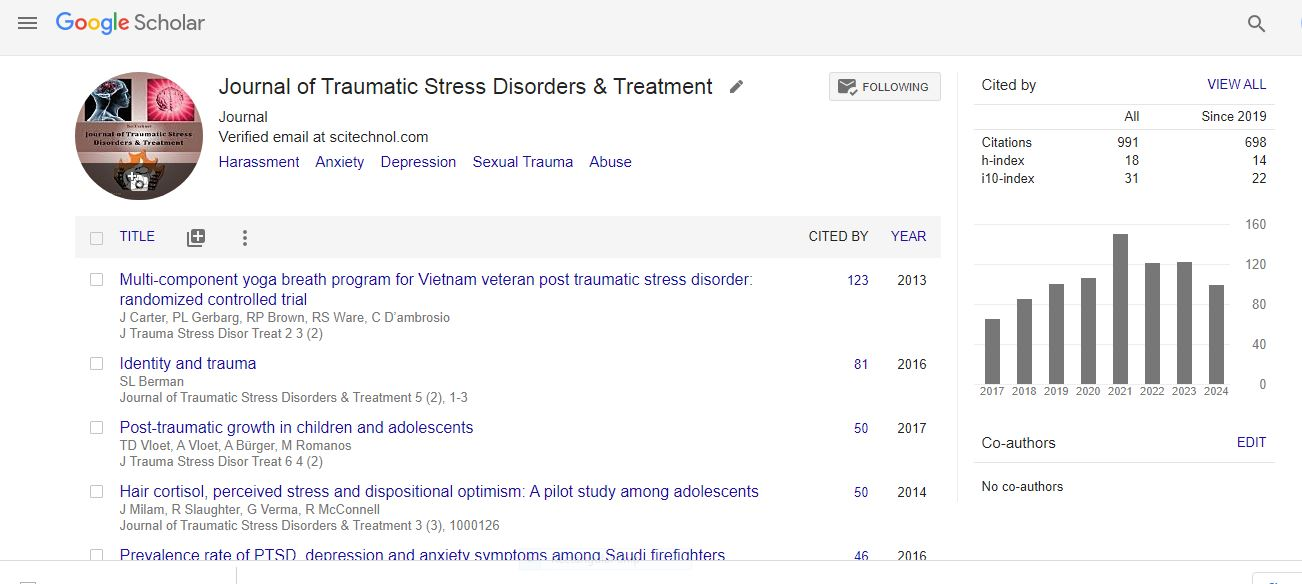Research Article, J Trauma Stress Disor Treat Vol: 11 Issue: 3
Effect of Medical Cannabis Authorization on Post-Traumatic Stress Disorder-related Mental Health Symptoms and Psychopharmacotherapy: A Cohort Study
Cerina Lee MPH1†, Dean T. Eurich1†, Jason R. B. Dyck2, Elaine Hyshka1, John G. Hanlon3,4, Arsene Zongo5,6*
1School of Public Health, University of Alberta, Edmonton, Alberta, Canada
2Cardiovascular Research Centre, Department of Pediatrics, Faculty of Medicine and Dentistry, University of Alberta, Edmonton, Alberta, Canada
3St. Michael’s Hospital Department of Anesthesia, Ontario, Canada
4Department of Anesthesiology and Pain Medicine, University of Toronto, Ontario, Canada
5Faculty of Pharmacy, Université Laval, Quebec City, Quebec, Canada
6Population Health and Optimal Health Practices Research Unit, CHU de Québec - university Laval Research Centre, Quebec City, Quebec, Canada
*Corresponding Author: Arsene Zongo
CHU de Quebec -Université Laval
Research Center,
Population Health and Optimal Health Practices Research Unit,
1050 Chemin Ste-Foy, Quebec City, Quebec, Canada
Tel: 418 682 7511 #81971
E-mail: arsene.zongo@pha.ulaval.ca
Received: 23-Feb-2022, Manuscript No. JTSDT-22-58064;
Editor assigned: 26-Feb-2022, PreQC No. JTSDT-22-58064(PQ);
Reviewed: 14-March-2022, QC No. JTSDT-22-58064;
Revised: 23-March-2022, Manuscript No. JTSDT-22-58064(R);
Published: 30-March-2022, DOI:10.4172/2324-8947.1000287
Citation: Cerina Lee MPH, Dean T. Eurich, Jason R. B. Dyck, Hyshka E, Hanlon JG, et al (2022) Effect of Medical Cannabis Authorization on Post-Traumatic Stress Disorder-related Mental Health Symptoms and Psychopharmacotherapy: A Cohort Study. J Trauma Stress Disor Treat 11:3.
Abstract
Background: Post traumatic stress disorder (PTSD) is a serious mental health disorder that can occur after the experience of a traumatic event. With increasing legalization of medical cannabis worldwide, there is both growing interest on its use to treat and manage PTSD. The objective of this study was assess the effect of medical cannabis authorization on mental health and psychopharmacotherapy among patients with post-traumatic stress disorder (PTSD) in Ontario, Canada.
Methods: This is a retrospective cohort study of patients aged ≥ 18 years, with PTSD who received medical cannabis authorization. Five PTSD-related outcomes were assessed from administrative data 6-months before and after cannabis authorization: Physician claims and emergency visits for any mental disorder; emergency department visits for depression/anxiety; dispensation of medications including psychotherapeutic drugs and prazosin. Interrupted time series analyses assessed the change in each outcome.
Results: Overall, >90% of individuals studied were between 18 and 60 years of age, and 55% (n=584) were female. Medical cannabis authorization did not have any significant effect on the four PTSD-related outcomes with the exception for the total number of days’ supply of psychotherapeutic drugs or prazosin that showed a temporal significant increase of days’ supply following cannabis authorization (+ 4567 days’ supply per 10,000 patients).
Conclusions: This longitudinal study found no significant association between medical cannabis authorization and improved outcomes for patients with PTSD. Continued surveillance of patients utilizing medical cannabis for PTSD treatment and management is warranted by clinicians to understand the long-term potential benefits and harms of ongoing use
 Spanish
Spanish  Chinese
Chinese  Russian
Russian  German
German  French
French  Japanese
Japanese  Portuguese
Portuguese  Hindi
Hindi 
